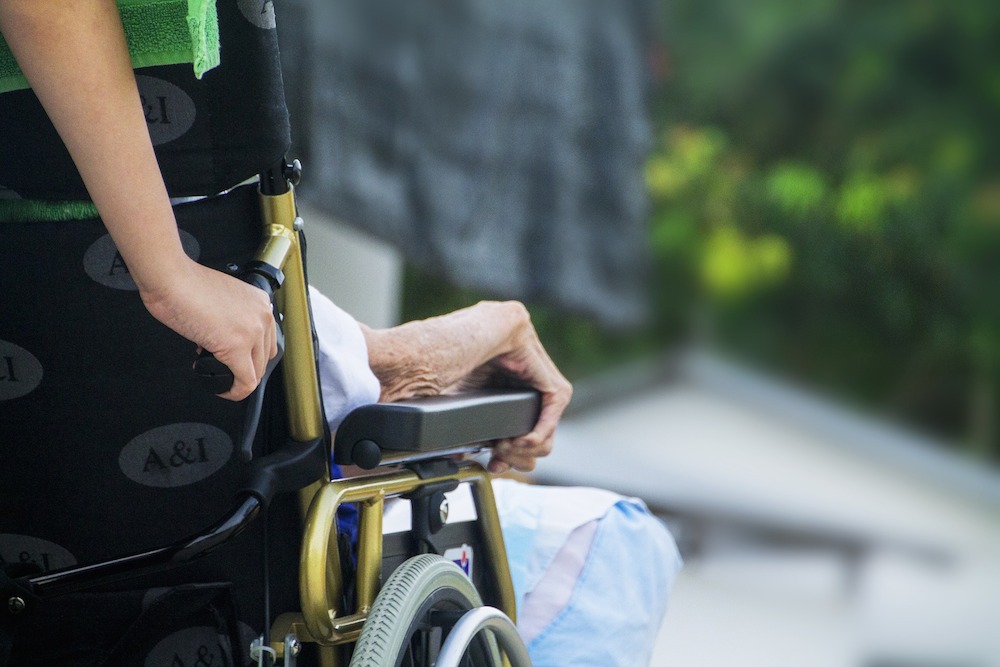Behind Closed Doors: Preventing Sexual Abuse in Nursing Homes
Families and care workers are learning how to protect vulnerable elderly women from this hidden crime. Pixabay / CC 2.0
Pixabay / CC 2.0
Thanks to this year’s media attention, sexual abuse in nursing homes is beginning to get the notice it deserves.
Public awareness of the crime is crucial because its victims—mostly women—are often hampered by cognitive and physical disorders, making it difficult or impossible for them to report it themselves. Experts say educating families and care workers to look for telltale signs is essential to combat this heinous behavior that’s hard to discover and prove.
Neglect is rampant in many long-term care facilities. Residents slump in their wheelchairs without being repositioned for hours, or they don’t get the help—and nourishment—they need at mealtimes.
Physical abuse isn’t always so obvious. It might result in bruises or broken bones, and while those injuries can be blamed on other causes, a pattern of symptoms can at least indicate something is wrong.
But sexual abuse is notoriously difficult to pin down.
“Sexual abuse is so hidden,” says Julie Schoen of the National Center on Elder Abuse. “The problem is that the population is vulnerable and often unable to communicate. That’s what makes it such a hidden crime.”
In February, CNN produced an exposé of elder sexual abuse, which inspired senior advocates to ramp up efforts to bolster awareness, prevention and punishment of the crime. Advocates are also trying to teach families who need care for loved ones to look for red flags that could indicate abuse.
“More and more, people are recognizing sex abuse as an issue,” says Karla Vierthaler of the National Sexual Violence Resource Center. “But like any other social justice movement, this one moves very slowly.”
Elder sexual abuse takes many forms, as outlined in the guide “The Prevention and Detection of Sexual Assault of Nursing Home Residents.” Hands-on assaults range from touching and kissing to outright rape. Hands-off behavior includes exhibitionism, sexual threats and display of pornographic materials.
Resident-on-resident abuse takes place, but more often the perpetrators are staff members within a facility.
Obstacles to change are daunting, largely because of entrenched staffing problems in long-term care facilities. “Care workers aren’t paid well, and there’s huge turnover,” Schoen says. As a result, many facilities are understaffed, so hiring precautions, including proper background checks, are often skipped. Such precautions could prevent the hiring of workers with criminal backgrounds—especially those charged with sex-related offenses.
Another problem concerns the training of long-term care employees. “Workers get 160 hours of training in a nursing home,” says Prescott Cole of California Advocates for Nursing Home Reform. “A hairdresser in California needs 1,600 hours.”
This lack of education means many workers aren’t adequately prepared to serve residents skillfully and respectfully—and they also aren’t able to recognize signs of sexual abuse by other workers.
“I tell a story about a staff member who came out of a resident’s room and was tying up his pants,” Vierthaler says. “Another staff member saw it and didn’t think about it. It didn’t even cross that person’s mind (that it could indicate sexual abuse).”
Ignorance and denial are major reasons staff and even family members don’t realize elders are being sexually abused.
In the Pacific Northwest, D. (who requested anonymity) knew her 85-year-old mother had met a male companion in her assisted living facility, but the daughter talked herself into thinking that “it was a friendship and that Mom had a pal to goof around with.” D.’s mother, who had Alzheimer’s disease, contracted a series of urinary tract infections, but D. didn’t recognize the source of the problem. When she walked into her mom’s room and found the man in bed with her, D. finally realized that “it wasn’t companionship—it was drinking and sexual abuse.”
D. faults the staff of her mother’s facility for failing to alert her of her mother’s sexual relations—and of the fact that the perpetrator had drinking and other problems. “When I was on my way to Mom’s room that day, they said, ‘You’re not going like this (finding the couple in bed).’ They knew what was going on and should have been more forthcoming. They definitely dropped the ball.”
Because D.’s mother suffered from Alzheimer’s disease, D. considers this a case of sexual abuse even though her mother seemed to consent to the intimate contact. “She was very mentally disabled, so it wasn’t really consensual,” D. says. “You knew there was no judgment behind it.” The facility agreed to lock D.’s mother’s door to prevent further sexual activity.
While frequent visits from friends and family are a key way to detect any sort of abuse, the burden of protection for long-term care residents falls on the facility.
“The nursing home bears the responsibility to (ensure) that residents aren’t abused,” says Lori Smetanka of The National Consumer Voice for Quality Long-Term Care.
A major association of nursing homes says it accepts that responsibility—at least on paper. Contacted for this article, the American Health Care Association emailed a statement that began: “The safety and well-being of residents and patients is a number one priority for all of our member skilled nursing centers and assisted living communities.” On the other hand, that organization declined a request to discuss the issue, saying, “None of our experts are available to talk so we will stick with our statement.”
In addition to detecting sexual abuse of elders, another formidable challenge is proving that it has taken place. The crime is often committed in a victim’s room at night, with no witnesses. Many victims—especially those who suffer from dementia or have lost the ability to speak—can’t remember, describe or even understand what has happened to them.
Some long-term care facilities make it even harder to prove the crime, says Cole, the attorney with California Advocates for Nursing Home Reform. They quickly clean up the scene of the crime so forensic evidence is destroyed, or fire the perpetrator, who goes on to work at another facility where the pattern of abuse can continue.
In spite of the barriers, advocates are tackling the issue, raising public awareness, educating professionals in the elder care field and helping families identify potential—and actual—abuse of their loved ones in long-term care facilities.
At its annual conference in November, The National Consumer Voice added a session on sexual abuse designed to teach elder care professionals, caregivers and family members how to look for verbal and nonverbal cues that indicate sexual abuse has taken place. Drawing from literature on the topic, signs include:
● Long-term care residents who have become unusually withdrawn or angry.
● A resident who shows signs of urgently wanting to leave the facility, or who begins to react negatively to particular staff members.
● Physical signs, including frequency of urinary tract infections and evidence of sexually transmitted diseases. (Symptoms of STDs can range from sores to unusual vaginal discharge, but the issue is complicated because many women with these diseases don’t exhibit symptoms at all.) Bruising around the mouth, genitals or rectum is a more obvious indicator that can be observed during bathing or dressing.
If family members or other parties recognize sexual abuse, they should first report it to their local law enforcement agency—some have elder abuse units—and also get in touch with a local long-term care ombudsman (an advocate who investigates complaints in facilities). If you suspect abuse in a location other than a long-term residence, contact your local adult protective services.
Some cities have legal units to look into and prosecute elder abuse. “We treat every allegation seriously,” says Paul Greenwood, who heads the San Diego District Attorney’s Elder Abuse Prosecution Unit. “If we get any reports, we send an investigator. The word being spread is ‘Hey, you’d better be careful, because the D.A. is looking over your shoulder.’ We see it as our job not just to prosecute but to have visibility and send a message that will reduce (abuse).”
Greenwood’s office has to go the extra mile for a successful prosecution, especially when a victim can’t communicate well.
“In one serious case we completed, a male employee sexually assaulted a 100-year-old resident,” Greenwood says. “He’s now serving a prison term. She (the resident) was able in her limited way to describe what he did to her. Through some very good police work and through my office, the defendant conceded there had been sexual activity. (At first) he said it was consensual but ultimately pleaded guilty.”
In an ongoing case, “a 19-year-old male employee was found by another employee with his penis exposed near a resident,” Greenwood says. “Some DNA indicates (sexual activity). Eventually he could face prison for raping an incapacitated adult.”
Prevention is better than any cure, so elder care professionals are increasing efforts to teach families how to choose safe facilities. D., whose mentally impaired mother was subject to sexual activity in a long-term care facility, cuts to the chase in this respect: “I think you have to include these in your checklist of things you’re monitoring: clean, safe, protected from predators.”
These practical recommendations come from “A Citizen’s Guide to Preventing and Reporting Elder Abuse”:
● Go online to view a facility’s rating, which includes staffing issues and quality of resident care. (Visit Nursing Home Compare and click on Health Inspections to learn about complaints filed and any resulting citations.)
● Visit facilities at different times, including weekends and nights.
● Carefully observe how staff members treat residents.
● Talk to families of other residents to find out what they think of the care.
● Get information from your long-term care ombudsman.
Families also can help bring this hidden topic out of the shadows. “Everyone I told about this was shocked,” D. says. “People don’t understand seniors are sexual beings. They think, ‘Put your parent in a facility, and they’ll be fine.’ ”
If you want to take action to cut down on sexual abuse, volunteer through an ombudsman’s office or become a citizen advocate. “These are often individuals who have had concerns with long-term care issues,” says Smetanka, executive director of The National Consumer Voice. “Some are formal groups. Most are small mom-and-pop groups around the kitchen table. They provide support to residents and families and try to (introduce change at the state level).”
Steps toward change may be slow, but they’re definitely taking place, according to Schoen, deputy director of the National Center on Elder Abuse. “We’re working to give (the elderly) their rights,” she says. “There are a lot of good people who want to make a difference.”
Your support matters…Independent journalism is under threat and overshadowed by heavily funded mainstream media.
You can help level the playing field. Become a member.
Your tax-deductible contribution keeps us digging beneath the headlines to give you thought-provoking, investigative reporting and analysis that unearths what's really happening- without compromise.
Give today to support our courageous, independent journalists.






You need to be a supporter to comment.
There are currently no responses to this article.
Be the first to respond.